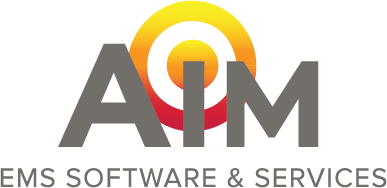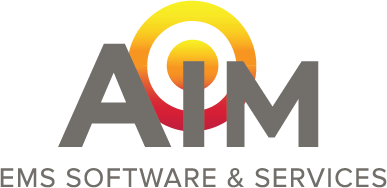.jpg?width=1500&height=856&name=Eliminate-Errors-Customize-Workflow%20(1).jpg)
User friendly ePCR software shouldn’t be a tough ask for EMS providers. Unfortunately, bad ePCR software is like an annoying rash, leading to seemingly endless frustrations for crews and Q/A specialists.
AIM knows the common struggles with ePCR software: difficulty maintaining accuracy, the inability to scale to the needs of the service, and an overall lack of worker satisfaction with reporting tools. Often, these issues with ePCRs are accepted as “part of the job,” and providers do their best to deal with it.
AIM believes this is wrong. EMS professionals shouldn’t have to settle for subpar tools. With that, let’s discuss the issues facing patient care reports, and then outline how AIM is fighting to provide solutions.
Why Ambulance Services Need Good Electronic Patient Care Reporting (ePCR) Software
Good software, be it billing software, ePCR software, or dispatch software, is instrumental to sustainable EMS work. While people on the street see the lights and the sirens; the EMS managers, dispatchers, crews, and billers see the day-to-day work.
Let’s quickly outline the needs of ambulances when it comes to EMS software, and then we’ll talk about some of the problems with patient care reporting software.
Reasons good ePCR software is vital:
- Patient care and data collection. First, ePCRs are about patient care. It’s about building an accurate health record so paramedics, nurses, and physicians can do their jobs without breaking the continuity of care. ePCRs also document data that help guide national EMS standards, further improving protocols surrounding patient care.
- Consistent, reliable reimbursement. ePCRs are also the foundation for the medical biller. The ePCR is where billers go to determine what happened on the call, including treatments, procedures, transport time, and transport destinations. An accurate ePCR means the patients are billed accurately and the ambulance services are paid regularly.
- QA (For training and remediation). ePCRs are also used for in-company training and quality assurance. They allow managers to conduct debriefings, allowing them to improve the collective effort and effectiveness of their care.
The patient care report is not a small part of an EMS professional’s life. Bring up the topic of ePCRs with any provider and they will have some thoughts on things they wished were different.
If there is a documentation workflow that is efficient and systematic, then EMS professionals can perform their jobs with optimum energy and reduced stress.
However, when these systems, such as dispatch software, billing tools, or ePCRs are not working optimally, it can cause distraction. And more. Indeed, these “little” problems become the holes that slowly drain the soul.
Common Problems with ePCR Software for Ambulance Companies
Sadly, EMS providers often struggle to find good ePCR software, and it can seem like the software presents a never-ending barrage of problems, each of which slows down the day, increases stress, and hinders strong patient care.
Problems with ePCR software:
- Many ePCR software tools are slow and behind the times
- Some ePCR software isn’t customizable to the needs of the service
- Outdated ePCR software causing endless tech problems
Let’s look at these issues a little closer.
Some ePCR Software is Too Slow (And Awkward to Use)
Some ePCR software doesn’t have a great user interface. The setup is confusing and counterintuitive, making crews feel like they are constantly inputting duplicate information, or leaving them unsure of what they’ve already completed. These roadblocks cause more problems than just wasted time.
An ePCR software platform that is difficult to use will hinder accuracy. While some may think the “methodical” nature of the software improves accuracy, sometimes it can be counterintuitive.
Why?
Crews will dread ePCRs that are clunky and difficult to use, leading to rushed documentation or putting the process off until the end of their shift (when important details of the call have already slipped their mind).
Some ePCR Software Is Not Customizable
The next issue? Some ePCR software isn’t customizable. This causes two problems.
First, it can leave people documenting things that are unneeded or unrelated to their area. This frustrates providers and wastes time. Even if they are just clicking "N/A," it's still a wasted keystroke.
Second, many areas will have special documentation requirements. If the ePCR can't be customized to these needs, then the EMS managers are left nagging crews to remember to "put it in the narrative." This can work in some cases, but it can cause issues overall.
Now let's address tech problems.
Some ePCR Software Creates Endless Tech Problems
Those EMS companies who host in-house software know how difficult it can be at times. On top of the upfront cost of the servers, there is a continued need to update computers and hire and pay IT professionals to service the system and fix any bugs.
Dealing with failing software isn’t fun. It can leave managers staying at the base long past the end of their day, trying to solve a problem. This leads to inaccurate documentation, and a permanent distaste of documentation among the crews, resulting in delays and low morale.
We’ve talked about the detriment of poor ePCR software, but now let’s look at how good software can turn things around.
How AIM’s ePCR Software Improves Ambulance Services
AIM has helped EMS providers with documentation for three decades and understands the unique needs of ambulance services around the world. AIM operates differently. Instead of creating software and then pushing it onto the EMS providers, we look at ambulance services first, listening to them and then ensuring we deliver what they need.
Many ambulance services don’t realize what a big difference good ePCR software can make.
Paramedics and EMTs are suddenly getting out of work on time, and they aren't making constant revisions to outstanding PCRs. Managers realize they are creating a more steady revenue cycle, they aren’t paying so much in overtime, nor are they constantly haggling staff to "finish that report."
Here are a few reasons AIM’s EMS Software makes a difference.
- The software focuses on maximizing revenus
- AIM offers the benefits of cloud-based ePCRs
- AIM’s software focuses on crew satisfaction and reducing wasted time
The next sections provide more details.
AIMs ePCR Software Focuses on Maximizing Revenue
There is no question that ambulances deserve to be paid, and part of getting paid is ensuring that accurate bills are sent out. AIMs ePCR software keeps things accurate. Accurate bills are more likely to go through, and much less likely to get hung up on the crew, the biller, or the payer.
We keep things accurate by making the ePCR interface simple, yet intuitive.
AIM also has an advantage when it comes to maximizing revenue. How? Because AIM also specializes in EMS billing software. This goes beyond just providing billing software, AIM employs in-house billers who know how to maximize revenue for ambulance services. But how does this relate to ePCR software?
Given that AIM understands the billing side of EMS, AIM can build ePCR software that perfectly integrates with an in-house and/or out-sources billing solution. This results in several benefits.
First, accurate ePCRs. When a patient encounter is properly documented, this allows billers to optimize revenue. Second, biller and road-staff relationships. AIM designs software that favors both parties, allowing them to work with each other, instead of constantly feeling like they are at odds.
If you’re curious about AIM’s billing software, read this guide to AIMs latest updates to their billing tools.
The Benefits of Cloud-based ePCRs (And Why the Cloud Makes EMS Managers Happy)
AIMs software not only improves the experience on the front end but also reduces the headaches on the back end. EMS directors and management no longer need to worry about maintaining complex services and performing constant updates. With the cloud, all you need is a strong internet connection.
Why cloud-based ePCRs change the game:
- The cloud is secure. Cloud-based software is secure for healthcare, and it’s used for both hospitals and clinics. Approved cloud-based ePCRs are HIPPA compliant and widely accepted.
- The cloud is simple and requires zero maintenance. No more maintaining servers in-house. All you have to do is think about the cost of the platform, there is no need to worry about hidden fees.
- Cloud ePCRs are simple to access.The cloud-based software allows EMS crews to use tablets and laptops to complete their reports. Also, the cloud follows them around, while remaining secure. They don’t need to worry about losing access to reports, because they are constantly updated and autosaved.
For more, read our guide to how cloud-based software will make an ambulance agency better.
Finally, let’s look at how AIMs ePCR software improves crew satisfaction.
AIMs Software Focuses on Crew and Manager Satisfaction
One thing that irritates everyone is wasting time on meaningless tasks. All of us surely remember a time when, either due to a mistake or poor planning, we spent time on a task that could have been avoided.
Here are several ways AIM's updated ePCR software makes EMS crews happy:
- No wasted time, no wasted keystrokes. AIM’s ePCR software optimizes both the content of the ePCR and the user interface. That means it’s simple to use and focuses on essential information.
- A commitment to accuracy and smoothing the relationship between billers and crews. AIM’s new ePCR software prevents crews from spending time correcting reports and helps them build positive relationships with billers.
- Molding to fit the ambulance agency. AIMs ePCR software covers all the bases, both national and state requirements, but it leaves ambulance companies breathing room to customize the software as they see fit.
Most EMS providers know how vitally important the ePCR is. In a sense, it guides every aspect of EMS. The patient care report guides the continuity of care, it guides billing, and the data collected from the report will guide future care protocols.
With all that said, many EMS providers feel that ePCRs are bloated, or imprecise. In some cases, the importance of certain aspects of the ePCR may need to be better communicated, but in other cases, the ePCR should be changed.
Conclusion: The Need for Strong ePCR Software
An ambulance service’s ePCR software, though it can be easy to overlook, is often either a key to their success or a thorn that constantly slows them down. In this world, where EMS professionals are facing many trials, there’s no reasons to make documentation one of those struggles.
Anyone working in EMS knows the stress of a subpoena or the time wasted correcting mistakes or the annoyance of inaccurate and irregular bills. AIMs ePCR software has implemented intuitive features that prevent errors, provide control, and protect the entire team. All this leads to satisfied crews, accurate reports, and less wasted time.
Contact AIM for a simple demonstration of their enhanced ePCR tools. A representative would be glad to hear the nuanced needs of your organization and figure out how AIM can help.






